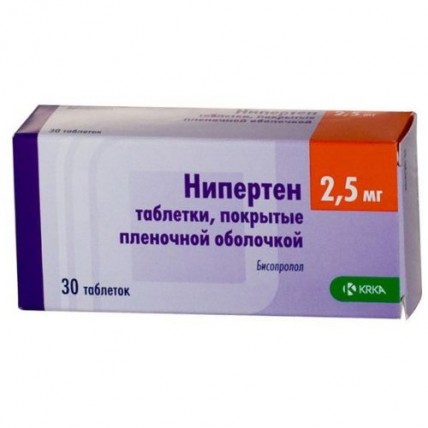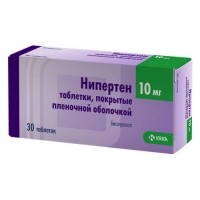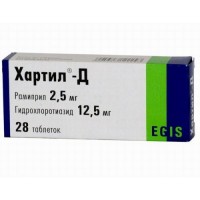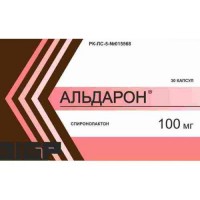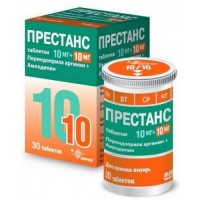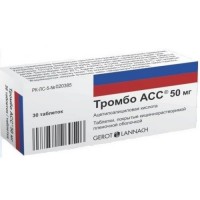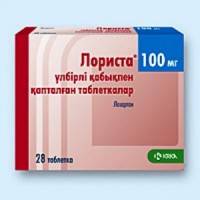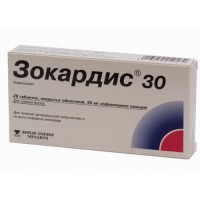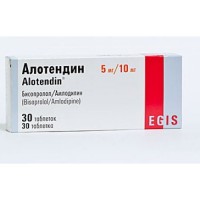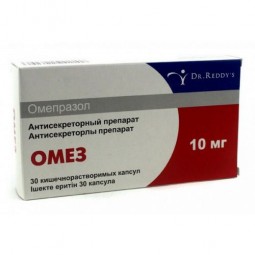Niperten 30s 2.5 mg film-coated tablets
- $6.40
The instruction for medical use
of NIPERTEN® medicine
the Trade name
of Niperten®
the International unlicensed
name Bisoprolol Lekarstvennaya
the Tablet form, film coated 2.5 mg, 5 mg and 10 mg
Structure
One tablet contains
active agent - the bisoprolola fumarates (2: 1) 2.50 mg, 5.00 mg and 10:00 mg,
excipients: microcrystalline cellulose, sodium of starch glikolit, povidone, silicon dioxide colloidal anhydrous, magnesium stearate,
a film cover: gipromelloza, polyethyleneglycol, titan dioxide E 171, talc.
The description
Oval biconvex tablets, film coated white color, with risky on one party and smooth on another (for a dosage of 2.5 mg).
Round biconvex tablets, film coated white color, with risky on one party and smooth on another (for dosages of 5 mg and 10 mg).
Pharmacotherapeutic group
β-adrenoblockers selection.
The code of automatic telephone exchange C07AB07
the Pharmacological
Pharmacokinetics Later properties of intake absorption is 80 – 90%, meal does not influence absorption. The maximum concentration in blood plasma is observed in 1–3 h, communication with proteins of blood plasma – about 30%. Permeability through a blood-brain barrier and a placental barrier – low. The bioavailability is about 85 - 90% after intake, meal does not affect bioavailability. Concentration of a bisoprolol in blood plasma are proportional to the accepted dose in
the range from 5 mg to 20 mg.
50% of the accepted dose are metabolized in a liver with formation of inactive metabolites, elimination half-life (T1/2) 10-12 hours. About 98% of a dose are removed by kidneys, less than 2% are brought out of them 50% in not changed look, – with bile.
The pharmacodynamics
of Niperten® - selection β1-адреноблокатор, without own sympathomimetic activity, does not possess membrane stabilizing action. Reduces activity of renin of blood plasma, reduces the need of a myocardium for oxygen, urezhat the heart rate (HR) (at rest and at loading). Нипертен® has hypotensive, antiarrhytmic and anti-anginal effect. Blocking in low doses β1-адренорецепторы hearts, Niperten® reduces stimulated catecholamines formation of cyclic adenosinemonophosphate (tsAMF) from adenosine triphosphate (ATP), reduces intracellular current of calcium ions (Sa2+), renders negative hrono-, dromo-, batmo- and inotropic action, reduces atrioventricular conductivity and excitability.
When exceeding a therapeutic dose has β2-адреноблокирующее effect.
The general peripheric vascular resistance at the beginning of drug Niperten® use, in the first 24 h, increases (as a result of reciprocal increase of activity of α-adrenoceptors and elimination of stimulation β2-адренорецепторов), in 1–3 days returns to initial, and at prolonged use – decreases.
The hypotensive effect is connected with reduction of minute volume of blood, sympathetic stimulation of peripheral vessels, recovery of sensitivity in response to a lowering of arterial pressure (ABP) and influence on the central nervous system (CNS). In arterial hypertensia the effect occurs in 2–5 days, stable action is noted in 1–2 months.
The anti-anginal effect of the drug Niperten® is caused by reduction of need of a myocardium for oxygen as a result of an urezheniye of frequency of warm reductions (ChSS) and decrease in contractility of a myocardium, lengthening of a diastole, improvement of perfusion of a myocardium. Due to increase in end diastolic pressure in a left ventricle and increases in stretching of muscle fibers of ventricles the need for oxygen, especially at patients with the chronic heart failure (CHF) can increase.
The antiarrhytmic effect of the drug Niperten® is caused by elimination of aritmogenny factors (tachycardias, superactivity of sympathetic nervous system, the increased maintenance of tsAMF, arterial hypertension), reduction of speed of spontaneous excitement of sinus and ectopic pacemakers and delay of atrioventricular (AV) carrying out (mainly in antegrade and, to a lesser extent, in the retrograde direction through an AV node) and on additional ways.
At use in average therapeutic doses, unlike non-selective β-adrenoblockers, Niperten® has less significant impact on the bodies containing β2-адренорецепторы (pancreas, skeletal muscles, smooth muscles of peripheral arteries, bronchial tubes and a uterus) and on carbohydrate metabolism, does not cause a delay of ions of sodium (Na+) in an organism, the expressiveness of atherogenous action does not differ from effect of propranolol.
Indications
- arterial hypertension
- coronary heart disease: prevention of attacks of angina of exertion
- chronic heart failure
the Route of administration and doses
Inside, in the morning on an empty stomach, without chewing, once.
Arterial hypertension and coronary heart disease: prevention of attacks of angina of exertion
Is recommended to accept 5 mg once. If necessary the dose is increased to 10 mg of 1 times a day. The maximum daily dose – 20 mg.
Patients with a renal failure at the clearance of creatinine (CC) have less than 20 ml/min., or with the profound abnormal liver functions the maximum daily dose – 10 mg.
Dose adjustment is not required from elderly patients.
Chronic heart failure
the Initiation of treatment of chronic heart failure the drug Niperten® demands obligatory carrying out the special period of selection dosed
Preliminary conditions to start therapy the following:
- HSN without signs of aggravation in the previous six weeks
- almost unchangeable basic therapy in the previous two weeks
- treatment by optimum doses of inhibitors of angiotensin-converting enzyme (APF) (and vasodilators, in case of intolerance of APF inhibitors), diuretics and, if necessary, cardiac glycosides
Treatment is appointed dosed according to the specified scheme of selection
the individual reaction of the patient to the appointed therapy, i.e. a dose Is possible it is possible to increase only if the previous dose was well transferred.
1ya week: 1.25 mg (1/2 tablets on 2.5 mg) once a day
2 I week: 2.5 mg once a day
3 I week: 3.75 mg once a day
4 I – 7 I week: 5 mg once a day
8 I – 11 I week: 7.5 mg once a day
12 I week and further: 10 mg once a day as maintenance therapy
the Maximum recommended dose of the drug Niperten® makes 10 mg once a day.
After an initiation of treatment drug in a dose of 1.25 mg (1/2 tablets of 2.5 mg) of the patient it is necessary to observe within about 4 hours (control of ChSS, the ABP, disturbance of conductivity on the ECG, signs of deterioration in chronic heart failure).
During the period of selection of doses or after it there can be a temporary deterioration in a course of HSN, a liquid delay in an organism, arterial hypotension or bradycardia. In this case it is recommended to pay, first of all, attention to selection of a dose of the accompanying basic therapy (to optimize a dose of diuretic and/or APF inhibitor), before a drug Niperten® dose decline. Drug treatment should be interrupted only in urgent cases.
After stabilization of a condition of the patient it is necessary to carry out repeated titration, or to continue treatment.
Treatment duration for all indications
Therapy by the drug Niperten® usually is long.
Side effects
Very often (≥ 1/10):
- sinus bradycardia
- a syndrome of cancellation (strengthening of attacks of stenocardia, increase in the ABP)
it is frequent (≥ 1/100 to
- disturbance of conductivity of a myocardium, easing of contractility of a myocardium,
- dizziness, a headache
- dryness of a mucous membrane of an oral cavity, change of taste, nausea,
vomiting, an abdominal pain, a constipation or diarrhea
- manifestation of a vasomotor spasm (strengthening of disturbance of peripheric
circulation, a cold snap of the lower extremities, Reynaud's syndrome)
- an asthenia, increased fatigue
Infrequently (≥ 1/1000 to
- disturbance of atrioventricular conductivity, heartbeat, arrhythmias,
development (aggravation) of HSN (puffiness of anklebones, feet, an asthma), sni-
zheny ABP
- congestion of a nose, difficulty of breath when assigning in high
doses (loss of selectivity) and/or at predisposed patients –
laringo- and a bronchospasm
- a myasthenia, a tremor, spasms (including gastrocnemius muscles)
- orthostatic hypotension
- sleep disorders, a depression
Seldom (≥ 1/10,000 to
- concern, confusion of consciousness or short-term loss of memory,
a hallucination
- a disorder of vision, reduction of secretion of plaintive liquid, dryness and
morbidity of eyes (it is necessary to consider when carrying
contact lenses by the patient)
- allergic reactions (rhinitis, a skin itching, rash, a small tortoiseshell)
- change of activity of enzymes of a liver (increase in ALT, nuclear heating plant, beat
a ruby, triglycerides)
- abnormal liver functions (dark urine, yellowness of scleras or skin,
a cholestasia)
- a hyperglycemia (at patients with non-insulin-dependent diabetes),
a hypoglycemia (at the patients receiving insulin), a hypothyroid
state
- sweating strengthening, a dermahemia
- weakening of a libido, decrease in potency,
Is very rare (
-paresthesias in extremities (at patients with the alternating lameness and
Reynaud's syndrome),
- a stethalgia
- conjunctivitis
- a dieback, psoriazopodobny skin reactions, aggravation of symptoms
of psoriasis, an alopecia
- thrombocytopenia (unusual bleedings and hemorrhages),
an agranulocytosis, a leukopenia
- a pre-natal growth inhibition, a hypoglycemia, bradycardia.
- a dorsodynia,
the Contraindication arthralgia
- hypersensitivity to a bisoprolol to a fumarat, other β-adrenoblockers and other components of drug
- shock (including cardiogenic)
- collapse
- a fluid lungs
- acute warm insufficiency
- chronic heart failure in a decompensation stage
- atrioventricular (AV) blockade of the II-III degree
- sinuatrial blockade
- a sick sinus syndrome
- the profound bradycardia (ChSS less than 50 beats/min)
- Printsmetal's stenocardia
- a cardiomegaly (without symptoms of heart failure)
- arterial hypotension (systolic arterial blood pressure up to 100 mm rt. St., especially in a myocardial infarction)
- severe forms of bronchial asthma and the chronic obstructive pulmonary disease (COPD) in the anamnesis
- a concomitant use of inhibitors of a monoaminooxidase (MAO) (except for MAO-B)
- late stages of disturbance of peripheric circulation
- a Raynaud's disease
- a pheochromocytoma (without simultaneous use of α-adrenoblockers)
- a metabolic acidosis
- children's and teenage age up to 18 years (the efficiency and safety are not established)
Medicinal interactions
the Allergens used for an immunotherapy, or extracts of allergens for skin tests increase risk of emergence of heavy system allergic reactions or an anaphylaxis at the patients receiving bisoprolol.
Yodosoderzhashchy X-ray contrast intravenous agents increase risk of development of anaphylactic reactions.
Phenytoinum at intravenous administration, means for inhalation anesthesia (derivatives of hydrocarbons) increase expressiveness of cardiodepressive action and probability of decrease in the ABP.
Changes efficiency of insulin and hypoglycemic means for intake, masks symptoms of the developing hypoglycemia (tachycardia, increase in the ABP).
Reduces clearance of lidocaine and xanthines (except theophylline) and increases their concentration in blood plasma, especially at patients with initially increased clearance of theophylline under the influence of smoking.
Hypotensive effect non-steroidal anti-inflammatory drugs (NPVP) (a delay of ions of sodium (Na+) and blockade of synthesis of prostaglandin kidneys) weaken, glucocorticosteroids and estrogen (delay of ions of Na+).
Cardiac glycosides, Methyldopum, reserpine and guanfatsin, blockers of slow calcium channels (verapamil, diltiazem), Amiodaronum and other antiarrhytmic means increase risk of development or aggravation of bradycardia, AV of blockade, cardiac arrest and heart failure.
Nifedipine can lead to considerable decrease in the ABP.
Diuretics, a clonidine, sympatholytics, gidralazin and other antihypertensives can lead to excessive decrease in the ABP.
Extends action of not depolarizing muscle relaxants and increases anticoagulating effect of coumarins.
Rub - and tetracyclic antidepressants, antipsychotic means (neuroleptics), ethanol, sedative and somnolent medicines strengthen oppression of central nervous system.
Simultaneous use with MAO inhibitors, owing to considerable strengthening of hypotensive action is not recommended, having rummaged in treatment between intake of MAO inhibitors and a bisoprolola has to make not less than 14 days.
Not hydrogenated alkaloids of an ergot increase risk of development of disturbances of peripheric circulation.
Ergotamine increases risk of development of disturbance of peripheric circulation, Sulfasalazinum increases concentration of a bisoprolol in blood plasma, rifampicin reduces T1/2.
Special instructions
do not interrupt treatment sharply and do not change the recommended dosage without preliminary consultation with the doctor as it can lead to temporary deterioration in action of the heart. Treatment should not be interrupted suddenly, especially at patients with coronary heart disease. If the termination of treatment is necessary, then the dosage should be reduced gradually.
Control of the patients taking the drug Niperten® has to include measurement of ChSS and the ABP (in an initiation of treatment – daily, then – 1 time in 3–4 months), carrying out the ECG, determination of level of glucose in blood at patients with diabetes (1 time in 4–5 months). At elderly patients it is recommended to monitor function of kidneys (1 time in 4–5 months).
It is necessary to train the patient in a technique of calculation of ChSS and to instruct about need of medical consultation at ChSS less than 50 ud. / min.
Before an initiation of treatment it is recommended to conduct a research of function of external respiration at patients with the burdened bronchopulmonary anamnesis.
Approximately at 20% of patients with stenocardia β-adrenoblockers are inefficient. Basic reasons: the profound coronary atherosclerosis with a low threshold of ischemia (ChSS less than 100 ud. / min.) and the increased final diastolic volume of a left ventricle breaking a subendocardial blood stream.
At smokers the efficiency of β-adrenoblockers is lower.
The patients using contact lenses have to consider that against the background of treatment the reduction of products of plaintive liquid is possible.
When using the patients with a pheochromocytoma have a risk of developing paradoxical arterial hypertension (if the effective α-adrenoblokada is previously not reached).
In a thyrotoxicosis of Niperten® can disguise certain clinical signs of a thyrotoxicosis (for example, tachycardia). Sharp cancellation at patients with a thyrotoxicosis is contraindicated as it is capable to strengthen symptomatology.
In diabetes of Niperten® can mask the tachycardia caused by a hypoglycemia. Unlike non-selective β-adrenoblockers practically does not strengthen the hypoglycemia caused by insulin and does not delay restoration of concentration of glucose in blood to normal level.
At a concomitant use of a clonidine its reception can be stopped only in several days after drug withdrawal of Niperten®.
Strengthening of expressiveness of hypersensitivity reaction and lack of effect of usual doses of epinephrine against the background of the burdened allergological anamnesis is possible.
In case of need performing planned surgical treatment carry out drug withdrawal for 48 h prior to the beginning of the general anesthesia. If the patient accepted Niperten® before surgical intervention, it should pick up medicine for the general anesthesia with minimum negative inotropic effect.
Reciprocal activation of vagus nerve can be eliminated with intravenous administration of atropine (1–2 mg).
The medicines reducing stocks of catecholamines (including reserpine), can strengthen effect of β-adrenoblockers therefore the patients accepting such combinations of medicines have to be under constant observation of the doctor regarding identification of the significant lowering of the ABP or bradycardia.
Patients with bronkhospastichesky diseases can appoint cardioselective β-adrenoblockers in case of intolerance and/or inefficiency of other antihypertensives. The overdose is dangerous by development of a bronchospasm.
In case of identification at patients of advanced age of the accruing bradycardia (less than 50 ud. / min.), the significant lowering of the ABP (systolic arterial blood pressure is lower than 100 mm Hg.), blockade AV, it is necessary to reduce a dose or to stop treatment.
It is recommended to stop therapy by the drug Niperten® at development of a depression.
It is impossible to interrupt sharply treatment because of danger of development of a syndrome of cancellation (heavy arrhythmias and a myocardial infarction). Cancellation is carried out gradually, reducing a dose within 2 weeks and more (lower a dose by 25% in 3-4 days). It is necessary to cancel before a research of content in blood and urine of catecholamines, a normetanefrin and vanilinmindalny acid, credits of antinuclear antibodies.
With care: a liver failure, chronic kidney disease, a myasthenia, a thyrotoxicosis, diabetes, AV blockade of the I degree, a depression (including in the anamnesis), psoriasis, allergic reactions (in the anamnesis), advanced age.
Pregnancies and the period of a lactation
it is possible in case the advantage for mother exceeds risk of development of side effects at a fruit and the child.
As a rule, beta blockers reduce a blood stream in a placenta and can influence fetation. It is necessary to trace attentively a blood stream in a placenta and a uterus and also to monitor growth and development of future child, and in case of dangerous manifestations concerning pregnancy or a fruit, to take alternative therapeutic measures.
It is necessary to examine carefully the newborn after the delivery. In the first three days of life there can be symptoms of decrease in level of glucose in blood and ChSS.
There are no data on excretion of a bisoprolol in breast milk or safety of impact of a bisoprolol on babies. Therefore administration of drug of Niperten® is not recommended to women during feeding by a breast.
Features of influence of medicine on ability to run the vehicle or potentially dangerous mechanisms
the Question of a possibility of occupations potentially dangerous types of activity requiring special attention and speed of psychomotor reactions should be solved only after assessment of individual reaction of the patient to drug (especially in an initiation of treatment, in connection with a possibility of development of dizziness).
Overdose
Symptoms: arrhythmia, ventricular premature ventricular contraction, profound bradycardia, AV blockade, significant decrease in the ABP, HSN, cyanosis of nails of fingers or palms, breath difficulty, bronchospasm, dizziness, unconscious states, spasms.
Treatment: gastric lavage and purpose of the adsorbing means, symptomatic therapy: at the developed AV to blockade – intravenous administration of 1-2 mg of atropine, epinephrine or temporary statement of a pacemaker, in ventricular premature ventricular contraction – lidocaine (the drugs IA of a class are not used), at decrease in the ABP – the patient has to be in position of Trendelenburg if there are no symptoms of a fluid lungs – intravenous administration of plasma substituting solutions, at inefficiency – administration of epinephrine, a dopamine, Dobutaminum (for maintenance of chronotropic and inotropic action and elimination of the significant decrease in the ABP), in heart failure – cardiac glycosides, diuretics, a glucagon, in spasms – intravenously diazepam, at a bronchospasm – β2-адреностимуляторы is inhalation.
A form of release and packing
On 10 tablets in blister strip packaging from a film of polyvinylchloride and aluminum foil.
On the 3rd blister strip packagings together with the instruction for use in the state and Russian languages place in a pack from cardboard.
To Store storage conditions at a temperature not above 30 °C.
To store out of children's reach!
A period of storage
2 years
not to apply after the storage expiration
Prescription status
According to the prescription
LLC KRKA-RUS Producer,
Russia Moskovskaya St., 50, 143500, Istra, the Moscow region, Russia
the Owner of the registration certificate
of KRK, of, the Place, Slovenia
the Address of the organization accepting in the territory of the Republic of Kazakhstan claims from consumers on quality of products (goods)
Representation KRK, of Is new. The place in PK
PK is new, 050059, Almaty, Al-Farabi Ave., 5/1, section 3 A, the 4th floor
ph.: +7 (727) 311 08 09
fax: +7 (727) 311 08 12
www.krka.si
to Develop
of NIPERTEN® medicine
the Trade name
of Niperten®
the International unlicensed
name Bisoprolol Lekarstvennaya
the Tablet form, film coated 2.5 mg, 5 mg and 10 mg
Structure
One tablet contains
active agent - the bisoprolola fumarates (2: 1) 2.50 mg, 5.00 mg and 10:00 mg,
excipients: microcrystalline cellulose, sodium of starch glikolit, povidone, silicon dioxide colloidal anhydrous, magnesium stearate,
a film cover: gipromelloza, polyethyleneglycol, titan dioxide E 171, talc.
The description
Oval biconvex tablets, film coated white color, with risky on one party and smooth on another (for a dosage of 2.5 mg).
Round biconvex tablets, film coated white color, with risky on one party and smooth on another (for dosages of 5 mg and 10 mg).
Pharmacotherapeutic group
β-adrenoblockers selection.
The code of automatic telephone exchange C07AB07
the Pharmacological
Pharmacokinetics Later properties of intake absorption is 80 – 90%, meal does not influence absorption. The maximum concentration in blood plasma is observed in 1–3 h, communication with proteins of blood plasma – about 30%. Permeability through a blood-brain barrier and a placental barrier – low. The bioavailability is about 85 - 90% after intake, meal does not affect bioavailability. Concentration of a bisoprolol in blood plasma are proportional to the accepted dose in
the range from 5 mg to 20 mg.
50% of the accepted dose are metabolized in a liver with formation of inactive metabolites, elimination half-life (T1/2) 10-12 hours. About 98% of a dose are removed by kidneys, less than 2% are brought out of them 50% in not changed look, – with bile.
The pharmacodynamics
of Niperten® - selection β1-адреноблокатор, without own sympathomimetic activity, does not possess membrane stabilizing action. Reduces activity of renin of blood plasma, reduces the need of a myocardium for oxygen, urezhat the heart rate (HR) (at rest and at loading). Нипертен® has hypotensive, antiarrhytmic and anti-anginal effect. Blocking in low doses β1-адренорецепторы hearts, Niperten® reduces stimulated catecholamines formation of cyclic adenosinemonophosphate (tsAMF) from adenosine triphosphate (ATP), reduces intracellular current of calcium ions (Sa2+), renders negative hrono-, dromo-, batmo- and inotropic action, reduces atrioventricular conductivity and excitability.
When exceeding a therapeutic dose has β2-адреноблокирующее effect.
The general peripheric vascular resistance at the beginning of drug Niperten® use, in the first 24 h, increases (as a result of reciprocal increase of activity of α-adrenoceptors and elimination of stimulation β2-адренорецепторов), in 1–3 days returns to initial, and at prolonged use – decreases.
The hypotensive effect is connected with reduction of minute volume of blood, sympathetic stimulation of peripheral vessels, recovery of sensitivity in response to a lowering of arterial pressure (ABP) and influence on the central nervous system (CNS). In arterial hypertensia the effect occurs in 2–5 days, stable action is noted in 1–2 months.
The anti-anginal effect of the drug Niperten® is caused by reduction of need of a myocardium for oxygen as a result of an urezheniye of frequency of warm reductions (ChSS) and decrease in contractility of a myocardium, lengthening of a diastole, improvement of perfusion of a myocardium. Due to increase in end diastolic pressure in a left ventricle and increases in stretching of muscle fibers of ventricles the need for oxygen, especially at patients with the chronic heart failure (CHF) can increase.
The antiarrhytmic effect of the drug Niperten® is caused by elimination of aritmogenny factors (tachycardias, superactivity of sympathetic nervous system, the increased maintenance of tsAMF, arterial hypertension), reduction of speed of spontaneous excitement of sinus and ectopic pacemakers and delay of atrioventricular (AV) carrying out (mainly in antegrade and, to a lesser extent, in the retrograde direction through an AV node) and on additional ways.
At use in average therapeutic doses, unlike non-selective β-adrenoblockers, Niperten® has less significant impact on the bodies containing β2-адренорецепторы (pancreas, skeletal muscles, smooth muscles of peripheral arteries, bronchial tubes and a uterus) and on carbohydrate metabolism, does not cause a delay of ions of sodium (Na+) in an organism, the expressiveness of atherogenous action does not differ from effect of propranolol.
Indications
- arterial hypertension
- coronary heart disease: prevention of attacks of angina of exertion
- chronic heart failure
the Route of administration and doses
Inside, in the morning on an empty stomach, without chewing, once.
Arterial hypertension and coronary heart disease: prevention of attacks of angina of exertion
Is recommended to accept 5 mg once. If necessary the dose is increased to 10 mg of 1 times a day. The maximum daily dose – 20 mg.
Patients with a renal failure at the clearance of creatinine (CC) have less than 20 ml/min., or with the profound abnormal liver functions the maximum daily dose – 10 mg.
Dose adjustment is not required from elderly patients.
Chronic heart failure
the Initiation of treatment of chronic heart failure the drug Niperten® demands obligatory carrying out the special period of selection dosed
Preliminary conditions to start therapy the following:
- HSN without signs of aggravation in the previous six weeks
- almost unchangeable basic therapy in the previous two weeks
- treatment by optimum doses of inhibitors of angiotensin-converting enzyme (APF) (and vasodilators, in case of intolerance of APF inhibitors), diuretics and, if necessary, cardiac glycosides
Treatment is appointed dosed according to the specified scheme of selection
the individual reaction of the patient to the appointed therapy, i.e. a dose Is possible it is possible to increase only if the previous dose was well transferred.
1ya week: 1.25 mg (1/2 tablets on 2.5 mg) once a day
2 I week: 2.5 mg once a day
3 I week: 3.75 mg once a day
4 I – 7 I week: 5 mg once a day
8 I – 11 I week: 7.5 mg once a day
12 I week and further: 10 mg once a day as maintenance therapy
the Maximum recommended dose of the drug Niperten® makes 10 mg once a day.
After an initiation of treatment drug in a dose of 1.25 mg (1/2 tablets of 2.5 mg) of the patient it is necessary to observe within about 4 hours (control of ChSS, the ABP, disturbance of conductivity on the ECG, signs of deterioration in chronic heart failure).
During the period of selection of doses or after it there can be a temporary deterioration in a course of HSN, a liquid delay in an organism, arterial hypotension or bradycardia. In this case it is recommended to pay, first of all, attention to selection of a dose of the accompanying basic therapy (to optimize a dose of diuretic and/or APF inhibitor), before a drug Niperten® dose decline. Drug treatment should be interrupted only in urgent cases.
After stabilization of a condition of the patient it is necessary to carry out repeated titration, or to continue treatment.
Treatment duration for all indications
Therapy by the drug Niperten® usually is long.
Side effects
Very often (≥ 1/10):
- sinus bradycardia
- a syndrome of cancellation (strengthening of attacks of stenocardia, increase in the ABP)
it is frequent (≥ 1/100 to
- disturbance of conductivity of a myocardium, easing of contractility of a myocardium,
- dizziness, a headache
- dryness of a mucous membrane of an oral cavity, change of taste, nausea,
vomiting, an abdominal pain, a constipation or diarrhea
- manifestation of a vasomotor spasm (strengthening of disturbance of peripheric
circulation, a cold snap of the lower extremities, Reynaud's syndrome)
- an asthenia, increased fatigue
Infrequently (≥ 1/1000 to
- disturbance of atrioventricular conductivity, heartbeat, arrhythmias,
development (aggravation) of HSN (puffiness of anklebones, feet, an asthma), sni-
zheny ABP
- congestion of a nose, difficulty of breath when assigning in high
doses (loss of selectivity) and/or at predisposed patients –
laringo- and a bronchospasm
- a myasthenia, a tremor, spasms (including gastrocnemius muscles)
- orthostatic hypotension
- sleep disorders, a depression
Seldom (≥ 1/10,000 to
- concern, confusion of consciousness or short-term loss of memory,
a hallucination
- a disorder of vision, reduction of secretion of plaintive liquid, dryness and
morbidity of eyes (it is necessary to consider when carrying
contact lenses by the patient)
- allergic reactions (rhinitis, a skin itching, rash, a small tortoiseshell)
- change of activity of enzymes of a liver (increase in ALT, nuclear heating plant, beat
a ruby, triglycerides)
- abnormal liver functions (dark urine, yellowness of scleras or skin,
a cholestasia)
- a hyperglycemia (at patients with non-insulin-dependent diabetes),
a hypoglycemia (at the patients receiving insulin), a hypothyroid
state
- sweating strengthening, a dermahemia
- weakening of a libido, decrease in potency,
Is very rare (
-paresthesias in extremities (at patients with the alternating lameness and
Reynaud's syndrome),
- a stethalgia
- conjunctivitis
- a dieback, psoriazopodobny skin reactions, aggravation of symptoms
of psoriasis, an alopecia
- thrombocytopenia (unusual bleedings and hemorrhages),
an agranulocytosis, a leukopenia
- a pre-natal growth inhibition, a hypoglycemia, bradycardia.
- a dorsodynia,
the Contraindication arthralgia
- hypersensitivity to a bisoprolol to a fumarat, other β-adrenoblockers and other components of drug
- shock (including cardiogenic)
- collapse
- a fluid lungs
- acute warm insufficiency
- chronic heart failure in a decompensation stage
- atrioventricular (AV) blockade of the II-III degree
- sinuatrial blockade
- a sick sinus syndrome
- the profound bradycardia (ChSS less than 50 beats/min)
- Printsmetal's stenocardia
- a cardiomegaly (without symptoms of heart failure)
- arterial hypotension (systolic arterial blood pressure up to 100 mm rt. St., especially in a myocardial infarction)
- severe forms of bronchial asthma and the chronic obstructive pulmonary disease (COPD) in the anamnesis
- a concomitant use of inhibitors of a monoaminooxidase (MAO) (except for MAO-B)
- late stages of disturbance of peripheric circulation
- a Raynaud's disease
- a pheochromocytoma (without simultaneous use of α-adrenoblockers)
- a metabolic acidosis
- children's and teenage age up to 18 years (the efficiency and safety are not established)
Medicinal interactions
the Allergens used for an immunotherapy, or extracts of allergens for skin tests increase risk of emergence of heavy system allergic reactions or an anaphylaxis at the patients receiving bisoprolol.
Yodosoderzhashchy X-ray contrast intravenous agents increase risk of development of anaphylactic reactions.
Phenytoinum at intravenous administration, means for inhalation anesthesia (derivatives of hydrocarbons) increase expressiveness of cardiodepressive action and probability of decrease in the ABP.
Changes efficiency of insulin and hypoglycemic means for intake, masks symptoms of the developing hypoglycemia (tachycardia, increase in the ABP).
Reduces clearance of lidocaine and xanthines (except theophylline) and increases their concentration in blood plasma, especially at patients with initially increased clearance of theophylline under the influence of smoking.
Hypotensive effect non-steroidal anti-inflammatory drugs (NPVP) (a delay of ions of sodium (Na+) and blockade of synthesis of prostaglandin kidneys) weaken, glucocorticosteroids and estrogen (delay of ions of Na+).
Cardiac glycosides, Methyldopum, reserpine and guanfatsin, blockers of slow calcium channels (verapamil, diltiazem), Amiodaronum and other antiarrhytmic means increase risk of development or aggravation of bradycardia, AV of blockade, cardiac arrest and heart failure.
Nifedipine can lead to considerable decrease in the ABP.
Diuretics, a clonidine, sympatholytics, gidralazin and other antihypertensives can lead to excessive decrease in the ABP.
Extends action of not depolarizing muscle relaxants and increases anticoagulating effect of coumarins.
Rub - and tetracyclic antidepressants, antipsychotic means (neuroleptics), ethanol, sedative and somnolent medicines strengthen oppression of central nervous system.
Simultaneous use with MAO inhibitors, owing to considerable strengthening of hypotensive action is not recommended, having rummaged in treatment between intake of MAO inhibitors and a bisoprolola has to make not less than 14 days.
Not hydrogenated alkaloids of an ergot increase risk of development of disturbances of peripheric circulation.
Ergotamine increases risk of development of disturbance of peripheric circulation, Sulfasalazinum increases concentration of a bisoprolol in blood plasma, rifampicin reduces T1/2.
Special instructions
do not interrupt treatment sharply and do not change the recommended dosage without preliminary consultation with the doctor as it can lead to temporary deterioration in action of the heart. Treatment should not be interrupted suddenly, especially at patients with coronary heart disease. If the termination of treatment is necessary, then the dosage should be reduced gradually.
Control of the patients taking the drug Niperten® has to include measurement of ChSS and the ABP (in an initiation of treatment – daily, then – 1 time in 3–4 months), carrying out the ECG, determination of level of glucose in blood at patients with diabetes (1 time in 4–5 months). At elderly patients it is recommended to monitor function of kidneys (1 time in 4–5 months).
It is necessary to train the patient in a technique of calculation of ChSS and to instruct about need of medical consultation at ChSS less than 50 ud. / min.
Before an initiation of treatment it is recommended to conduct a research of function of external respiration at patients with the burdened bronchopulmonary anamnesis.
Approximately at 20% of patients with stenocardia β-adrenoblockers are inefficient. Basic reasons: the profound coronary atherosclerosis with a low threshold of ischemia (ChSS less than 100 ud. / min.) and the increased final diastolic volume of a left ventricle breaking a subendocardial blood stream.
At smokers the efficiency of β-adrenoblockers is lower.
The patients using contact lenses have to consider that against the background of treatment the reduction of products of plaintive liquid is possible.
When using the patients with a pheochromocytoma have a risk of developing paradoxical arterial hypertension (if the effective α-adrenoblokada is previously not reached).
In a thyrotoxicosis of Niperten® can disguise certain clinical signs of a thyrotoxicosis (for example, tachycardia). Sharp cancellation at patients with a thyrotoxicosis is contraindicated as it is capable to strengthen symptomatology.
In diabetes of Niperten® can mask the tachycardia caused by a hypoglycemia. Unlike non-selective β-adrenoblockers practically does not strengthen the hypoglycemia caused by insulin and does not delay restoration of concentration of glucose in blood to normal level.
At a concomitant use of a clonidine its reception can be stopped only in several days after drug withdrawal of Niperten®.
Strengthening of expressiveness of hypersensitivity reaction and lack of effect of usual doses of epinephrine against the background of the burdened allergological anamnesis is possible.
In case of need performing planned surgical treatment carry out drug withdrawal for 48 h prior to the beginning of the general anesthesia. If the patient accepted Niperten® before surgical intervention, it should pick up medicine for the general anesthesia with minimum negative inotropic effect.
Reciprocal activation of vagus nerve can be eliminated with intravenous administration of atropine (1–2 mg).
The medicines reducing stocks of catecholamines (including reserpine), can strengthen effect of β-adrenoblockers therefore the patients accepting such combinations of medicines have to be under constant observation of the doctor regarding identification of the significant lowering of the ABP or bradycardia.
Patients with bronkhospastichesky diseases can appoint cardioselective β-adrenoblockers in case of intolerance and/or inefficiency of other antihypertensives. The overdose is dangerous by development of a bronchospasm.
In case of identification at patients of advanced age of the accruing bradycardia (less than 50 ud. / min.), the significant lowering of the ABP (systolic arterial blood pressure is lower than 100 mm Hg.), blockade AV, it is necessary to reduce a dose or to stop treatment.
It is recommended to stop therapy by the drug Niperten® at development of a depression.
It is impossible to interrupt sharply treatment because of danger of development of a syndrome of cancellation (heavy arrhythmias and a myocardial infarction). Cancellation is carried out gradually, reducing a dose within 2 weeks and more (lower a dose by 25% in 3-4 days). It is necessary to cancel before a research of content in blood and urine of catecholamines, a normetanefrin and vanilinmindalny acid, credits of antinuclear antibodies.
With care: a liver failure, chronic kidney disease, a myasthenia, a thyrotoxicosis, diabetes, AV blockade of the I degree, a depression (including in the anamnesis), psoriasis, allergic reactions (in the anamnesis), advanced age.
Pregnancies and the period of a lactation
it is possible in case the advantage for mother exceeds risk of development of side effects at a fruit and the child.
As a rule, beta blockers reduce a blood stream in a placenta and can influence fetation. It is necessary to trace attentively a blood stream in a placenta and a uterus and also to monitor growth and development of future child, and in case of dangerous manifestations concerning pregnancy or a fruit, to take alternative therapeutic measures.
It is necessary to examine carefully the newborn after the delivery. In the first three days of life there can be symptoms of decrease in level of glucose in blood and ChSS.
There are no data on excretion of a bisoprolol in breast milk or safety of impact of a bisoprolol on babies. Therefore administration of drug of Niperten® is not recommended to women during feeding by a breast.
Features of influence of medicine on ability to run the vehicle or potentially dangerous mechanisms
the Question of a possibility of occupations potentially dangerous types of activity requiring special attention and speed of psychomotor reactions should be solved only after assessment of individual reaction of the patient to drug (especially in an initiation of treatment, in connection with a possibility of development of dizziness).
Overdose
Symptoms: arrhythmia, ventricular premature ventricular contraction, profound bradycardia, AV blockade, significant decrease in the ABP, HSN, cyanosis of nails of fingers or palms, breath difficulty, bronchospasm, dizziness, unconscious states, spasms.
Treatment: gastric lavage and purpose of the adsorbing means, symptomatic therapy: at the developed AV to blockade – intravenous administration of 1-2 mg of atropine, epinephrine or temporary statement of a pacemaker, in ventricular premature ventricular contraction – lidocaine (the drugs IA of a class are not used), at decrease in the ABP – the patient has to be in position of Trendelenburg if there are no symptoms of a fluid lungs – intravenous administration of plasma substituting solutions, at inefficiency – administration of epinephrine, a dopamine, Dobutaminum (for maintenance of chronotropic and inotropic action and elimination of the significant decrease in the ABP), in heart failure – cardiac glycosides, diuretics, a glucagon, in spasms – intravenously diazepam, at a bronchospasm – β2-адреностимуляторы is inhalation.
A form of release and packing
On 10 tablets in blister strip packaging from a film of polyvinylchloride and aluminum foil.
On the 3rd blister strip packagings together with the instruction for use in the state and Russian languages place in a pack from cardboard.
To Store storage conditions at a temperature not above 30 °C.
To store out of children's reach!
A period of storage
2 years
not to apply after the storage expiration
Prescription status
According to the prescription
LLC KRKA-RUS Producer,
Russia Moskovskaya St., 50, 143500, Istra, the Moscow region, Russia
the Owner of the registration certificate
of KRK, of, the Place, Slovenia
the Address of the organization accepting in the territory of the Republic of Kazakhstan claims from consumers on quality of products (goods)
Representation KRK, of Is new. The place in PK
PK is new, 050059, Almaty, Al-Farabi Ave., 5/1, section 3 A, the 4th floor
ph.: +7 (727) 311 08 09
fax: +7 (727) 311 08 12
www.krka.si
to Develop
